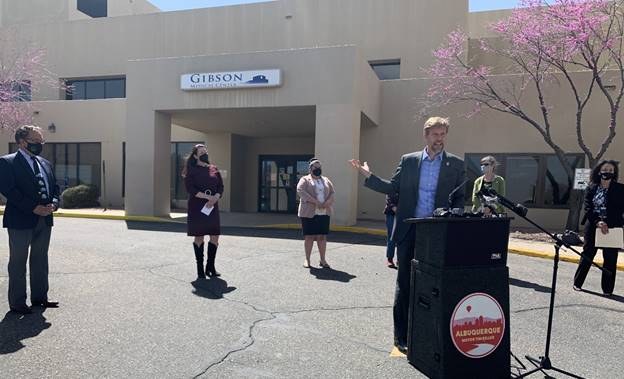
City of Albuquerque Acquires Gibson Medical Center, Cornerstone of Gateway Shelter Network
Keller administration makes largest capital investment in housing security in the city’s history.
April 6, 2021
Today, Mayor Tim Keller, City, County, and State leaders announced that the $15 million purchase of the Gibson Medical Center has been finalized. In 2019, Albuquerque voters approved the City’s proposal to make a historic investment for the unhoused and expand the City’s capacity to support individuals as they transition to stable permanent housing.
The City led months of study and extensive public input and created the Homelessness Coordinating Council together with Bernalillo County and the University of New Mexico. The process produced plans for a multi-site Gateway Center Service Network model to expand on the capacity of the existing system of care, provide 24/7 emergency shelter, and give individuals access to long-term services that will reduce the number of people living on the streets. The newly acquired Gibson Medical Center is now positioned to be a cornerstone of that network.
“Today, there are roughly 5,000 Albuquerque households that experience homelessness over the course of a year and we can lack 500 beds on any given night. When we are confronted with tough issues like these, we have to lead with our values and take compassionate action. The opposite of compassion would be saying ‘there’s no room at the inn,’” said Mayor Tim Keller. “Thanks to the voters, we now have a 570,000 square foot facility that has played a role in healing our community for decades. It’s a huge step towards making our vision of an integrated system a reality, but our work to continue the public input process with neighborhoods and activate the site is just beginning.”
The $15 million acquisition represents the largest capital investment the City has ever made in addressing homelessness. $13.5 million in the deal’s funding comes from city funds, including the voter-approved bond, $1 million is provided by Bernalillo County. Additional support for the Gateway project comes from state capital outlay allocations -- including $500,000 from State Senator Katy Duhigg -- and from a consortium of private businesses: Bank of Albuquerque, French Funerals and Cremations, New Mexico Mutual, PNM Resources, and Presbyterian Healthcare Services.
CAPTION: Lawrence Rael, City of Albuquerque COO; State Senator Katy Duhigg; Bernalillo County Commissioner Adriann Barboa; Mayor Tim Keller; Lisa Huval, Family and Community Deputy Director; and Carol Pierce, Family and Community Services Director; Bernalillo County Manager Julie Morgas Baca gather to announce the $15 million purchase of the Gibson Medical Center
“Homelessness is a challenge that impacts all of us and addressing it requires a community-based approach,” said Lawrence Rael, City of Albuquerque Chief Operating Officer. “Over the past year, we have convened the Homelessness Coordinating Council, a dedicated group of leaders from the City, County, and the University of New Mexico that has organized the joint effort to tackle this issue and gather extensive public input through an open process that continues today. Without this level of engagement, we would never have been able to adapt as we have throughout the process of siting the Gateway Center and securing this incredible facility.”
“Addressing homelessness from every angle means providing emergency shelter, health care services, and the resources and support that will help individuals transition into permanent housing. That’s what we’re building towards with the Gateway Centers network,” said Carol Pierce, City of Albuquerque Family and Community Services Director. “The acquisition of the Gibson Medical Center provides an anchor for this network and we are excited to move forward with our partners to continue this urgent work.”
The acquisition of the Gibson Center comes at a time of great need in the Albuquerque Metro area. A 2019 report showed that the city's shelter system lacked roughly 500 emergency beds and could not sufficiently transition residents into permanent housing, a shortcoming only exacerbated by the COVID-19 pandemic. In addition to launching the Gateway Centers initiative, the City of Albuquerque has made new investments to address housing insecurity, including $6 million in funding for supportive housing programs in the City budget. This week, the City also opened applications for $21.6 million in state-funded emergency rental assistance that will be critical to keeping economically vulnerable families in their homes.
“The Gibson Medical Center has long been a pillar of health services in Albuquerque and Bernalillo County. The City’s work to negotiate and finalize this acquisition ensures that this facility will continue to serve the public good for years to come,” said Bernalillo County Manager Julie Morgas Baca. “The County looks forward to continuing our active partnership with the public and the Homelessness Coordinating Council as we take the next steps to secure safe housing for residents in need.”
"If you grew up in Albuquerque, you know and love someone that could use the services that will be provided in this building. Acquiring the Gibson Medical Center is a landmark step in our efforts to address substance use and unsheltered community and meet them where they are with resources they need," said County Commissioner Adriann Barboa. “This location allows us to begin operations in a matter of months, not years. That’s significant for those our neighbors in need today. When we focus resources to our communities in most need, we all benefit, I am proud to have this source of love, resource and hope in my neighborhood.
“Anchoring the Gateway Center network in the Gibson Medical Center opens so many opportunities for services,” said State Senator Katy Duhigg. “Important service providers like the Turquoise Lodge for substance abuse treatment are already located in the facility, and the location is versatile and can accommodate future needs. I’m grateful to everyone involved for their determination and for centering community input throughout this process.”

